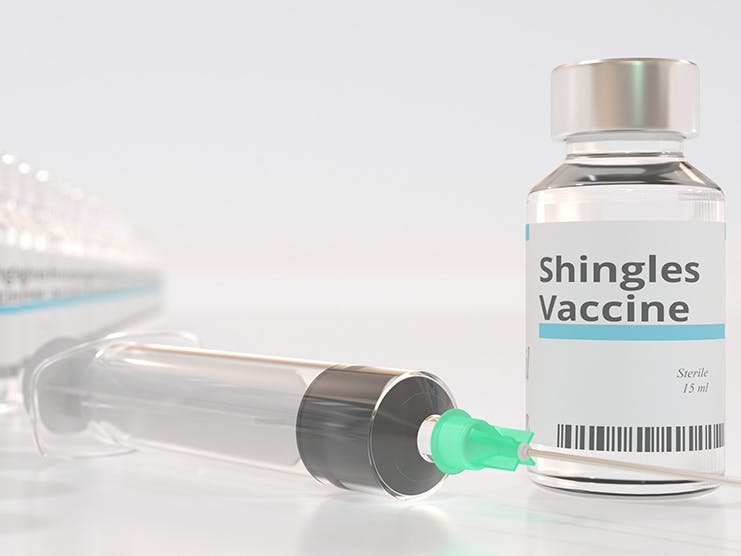
Remember that itchy chickenpox you got as a child? Turns out it can come back and haunt you later in life.
More than one in three adults will develop a condition called shingles, otherwise known as herpes zoster, during their lifetime, often after the age of 65. Even after you recover from chickenpox, the virus still lurks in your body. Decades later, it can reactivate, causing the blistering, painful rash that’s known as shingles.
But shingles is more than just an annoyance. At least one in ten people who get shingles develop nerve pain that lasts for months, or even years. It’s called postherpetic neuralgia (PHN) and the pain can be so severe and debilitating that it interferes with your daily life. While it can happen to anyone, the risk goes up with age. The older you are, the more likely you are to get PHN, and to have it last longer and be more painful.
That’s not all that can happen with shingles, either. Up to four percent of all people with shingles can be hospitalized for complications that include:
- Blindness
- Pneumonia
- Hearing problems
- Encephalitis (brain inflammation)
You’re particularly vulnerable if you already have a condition that affects your immune system, such as a blood cancer, HIV, or an autoimmune condition.
Fortunately, a new shingles vaccine, Shingrix, is available. It works much better than the earlier vaccine, Zostavax–so much better, in fact, that Zostavax is no longer being offered in the United States.
“This vaccine has spectacular initial protection rates in every age group,” William Schaffner, MD, a preventive disease specialist at the Vanderbilt University School of Medicine, told the New York Times when the vaccine was first approved. “The immune system of a 70- or 80-year-old responds as if the person were only 25 or 30.”
Here’s a look at some of the most common Shingrix-related questions you may have.
Who should get Shingrix?
All adults over the age of 50 should get the Shingrix vaccine. It’s two doses, separated by two to six months. (If you have a weakened immune system from cancer or another disease, it’s recommended that you get the second shot sooner, usually a month or two after the first.)
You should still get Shingrix even if you’ve already:
- Had shingles. Research shows that about six percent of people who have had shingles will get it again within eight years. While there’s no specific amount of time you need to wait after you’ve had shingles to get Shingrix, it’s a good idea to make sure that the rash is completely gone.
- Gotten the earlier shingles vaccine. The new vaccine is much more effective than Zostavax. The CDC recommends getting Shingrix even if you’ve been previously vaccinated.
- Gotten the varicella (chickenpox) vaccine. Chances are, you had chickenpox as a kid, even if you don’t remember getting it. More than 99 percent of Americans born before 1980 have had it, according to the Centers for Disease Control and Prevention. The chickenpox vaccine won’t protect you from getting shingles if the virus is already in your body. You never “age out” of getting the Shingrix vaccine, either. You can get it whether you’ve just turned 50 or are pushing 100.
I got the older shingles vaccine and still got shingles. Why bother?
Although Zostavax was an important tool against shingles, its protection was limited. It reduced the risk of developing shingles by 51 percent, and the risk of PHN by 67 percent in adults over age 60.
By contrast, two doses of Shingrix provide very strong protection both against shingles and PHN. Here’s what research shows:
- Shingrix is 97 percent effective in preventing shingles in healthy adults in their 50s and 60s.
- Shingrix is 91 percent effective in preventing shingles in adults 70 years and older.
- Shingrix is about 90 percent effective in preventing PHN in all adults over the age of 50
- Shingrix is between 68 percent and 91 percent effective to prevent shingles in adults with weakened immune systems, depending on their underlying medical complications.
What’s more, protection doesn’t seem to wane over time. People over the age of 70 still have high levels of shingles immunity even seven years after vaccination!
If it’s been less than five years since you got the Zostavax vaccine, talk to your doctor. While studies show that Shingrix is safe and effective if it’s given at least five years after Zostavax, there’s no research about a shorter time frame. But many doctors will still recommend that you go ahead and get Shingrix anyway, especially if you’re over the age of 70.
Is there anyone who shouldn’t get Shingrix?
This vaccine is safe for the vast majority of adults over the age of 50. But there are a few times when it’s not recommended. Your doctor may advise you not to get Shingrix if:
- You’ve ever had a severe allergic reaction such as hives, facial swelling, trouble breathing, or a fast heartbeat. This is very rare, occurring in less than one or two cases out of a million doses.
- You currently have shingles. You should wait until your rash has fully disappeared.
- You’re sick enough to run a fever. You can get the vaccine once you’ve recovered. If you just have a minor cold, though, it’s fine to get vaccinated.
What are the side effects of Shingrix?
You may have very mild side effects that last a couple days. These include:
- Sore arm
- Redness and swelling where you got the shot
- Fatigue
- Muscle pain
- Headache
- Chills
- Fever
- Stomach pain
- Nausea
Interestingly, the younger you are, the more likely you are to experience side effects. This may be because your immune system is more robust. It’s safe to take an over-the-counter pain reliever like ibuprofen or acetaminophen to help with some of these symptoms.
Can I get Shingrix at the same time as other shots?
Yes. The virus in Shingrix isn’t active, so it can be given at the same time as you get other vaccines, such as your COVID-19 booster or your annual flu shot. Just make sure that you get the shots in different arms.
The one exception is the chicken-pox vaccine. You’ll need to wait at least eight weeks between shots if you’re getting both.
How do I pay for Shingrix?
Here’s some good news: Shingrix is covered under your Medicare Part D plan. Depending on your plan, you may have a copay.
If you have trouble meeting your copay, Shingrix’s manufacturer, GlaxoSmithKline, offers a financial assistance program for the vaccine. To qualify, you’ll need to be enrolled in a Medicare Part D prescription drug plan and have spent at least $600 on your prescription meds through the plan for the current calendar year. Your primary care provider can register you in the assistance program.
Do you have Medicare questions? We have answers.
When it comes to Medicare, one plan definitely does not fit all. At ClearMatch, it’s our mission to match you to the policy that best serves your unique needs. It’s all we do, and we do it better than anyone. Check out our extensive library of articles for answers to your Medicare questions. Or, compare plans in your area to get started finding the policy that’s right for you.
Additional Resources
Does Medicare Cover Immunization?
Internal Website Link
What Is Medicare Part D?
Internal Website Link
Find a Plan
Internal Website Link
“Shingles Vaccination”
External Website Link
“What Everyone Should Know About Zostavax”
External Website Link
Frequently Asked Questions about Shingrix
External Website Link
About Shingles
External Website Link
Shingles Vaccine: Should I Get It?
External Website Link
Shingles Vaccine
External Website Link


